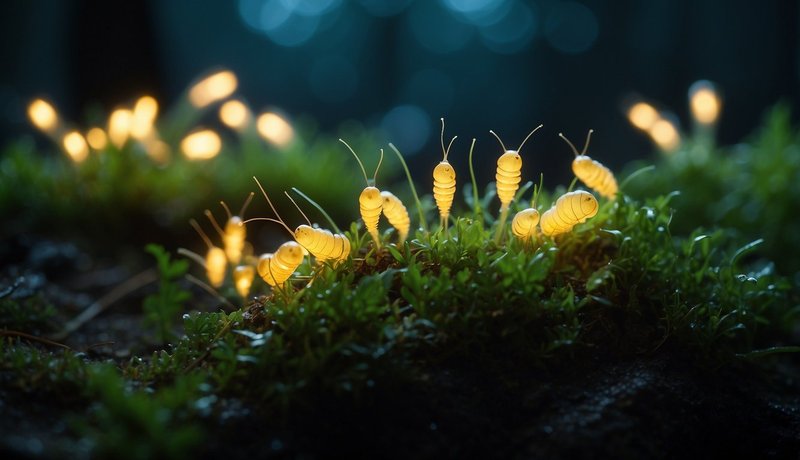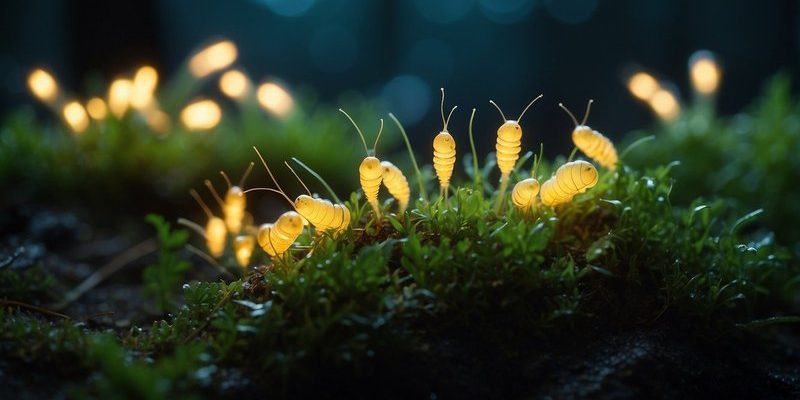
Glow worms, often found in moist, dark areas, are fascinating little creatures that contribute significantly to forest health. Let’s dive into the incredible impact they have on their environment, and understand why they deserve our attention—not just because they look cool, but because they play several key roles in maintaining the balance of the ecosystem.
What Are Glow Worms?
Glow worms are not actually worms; they’re the larval stage of various beetles belonging to the Lampyridae family. You might know them better as fireflies or lightning bugs. The most famous type of glow worm is the *Lampyris noctiluca*, usually seen in Europe, while others vary by region. These larvae glow as a way to attract mates and, more importantly, to lure prey.
You might be wondering how these little guys create their glow. They produce light through a chemical reaction in their bodies, which is pretty neat! It’s similar to how a light bulb works but comes straight from nature. This bioluminescence not only serves as a survival tactic for the glow worm but also adds a touch of magic to forest ecosystems.
Glow Worms as Predators
One of the most significant roles glow worms play in their ecosystems is that of predators. They primarily feed on small insects, which they attract with their glowing light. When an unsuspecting bug comes too close, it gets caught in the sticky silk threads that glow worms produce. It’s like setting a trap for dinner!
This predatory behavior helps maintain insect populations within the forest. Just like a gardener prunes plants to keep them healthy, glow worms control pest populations. Without them, certain insects could overpopulate, leading to a disrupted balance in the ecosystem. Think of glow worms as tiny pest controllers that contribute to the plants’ and trees’ overall health.
Food Source for Other Wildlife
While glow worms are skilled hunters, they also become prey for other animals in the food chain. Birds, bats, and even larger insects find them a tasty snack. This relationship is crucial; it helps sustain a balanced ecosystem by providing nourishment to various predators.
Each organism in the forest, from the tiniest glow worm to the largest predator, relies on one another. If glow worms were to disappear, it would create a ripple effect—birds would struggle to find food, leading to a decline in their populations, and ultimately affecting other species. It’s the circle of life, and glow worms play an essential part in it.
The Role of Glow Worms in Soil Health
Have you ever thought about how important the soil is in a forest ecosystem? It’s the foundation for everything! Glow worms contribute to soil fertility through their life cycle. As they consume insects and eventually decompose, their bodies return nutrients to the soil. This process enriches the earth, helping plants grow strong and healthy.
By supporting soil health, glow worms help ensure that trees and plants have the nutrients they need to thrive. Healthy plants mean a flourishing forest, which benefits all the creatures that call it home. Honestly, glow worms are small but mighty when it comes to nurturing the land.
Glow Worm Habitats: Where to Find Them
You might be curious about where you can spot these glowing wonders. Glow worms typically thrive in moist, dark environments, such as caves, forests, and even some gardens. They prefer areas with plenty of organic matter, which provides them a suitable habitat to hunt for their insect prey.
In places like New Zealand, glow worm caves are popular tourist attractions, showcasing the breathtaking sight of thousands of glow worms lighting up the darkness. If you find yourself wandering through a forest, look for damp, shaded areas—you might just be lucky enough to catch a glimpse of these enchanting creatures illuminating the night.
Conservation of Glow Worms
Like many species, glow worms face threats from habitat loss, pollution, and climate change. Light pollution, in particular, can disrupt their mating rituals and hunting behaviors. This is a significant concern because fewer glow worms means a more unbalanced ecosystem.
Conservation efforts are crucial to protecting glow worms and their habitats. Simple actions, like reducing outdoor lighting at night or protecting natural areas from development, can help these magnificent insects thrive. By taking care of our forests, we’re not just saving glow worms; we’re preserving a whole world of biodiversity.
Why Glow Worms Matter to Us
You might think, “Why should I care about glow worms?” Here’s the thing: they symbolize the health of our natural environment. Their presence is a strong indicator of a flourishing ecosystem. A habitat rich in species diversity not only supports glow worms but countless other organisms, including ourselves.
By cherishing and protecting these small creatures, we’re also safeguarding the intricate web of life in our forests. Their health reflects the well-being of the entire ecosystem, reminding us how interconnected everything truly is.
In conclusion, glow worms are much more than just pretty lights in the forest. They play a vital role in maintaining the balance of life by serving as predators, prey, and contributors to soil health. By understanding and protecting these fascinating creatures, we can ensure that they continue to illuminate our natural world for generations to come. So next time you wander through a forest at night, keep an eye out for those little green glimmers—they’re doing important work behind the scenes!

